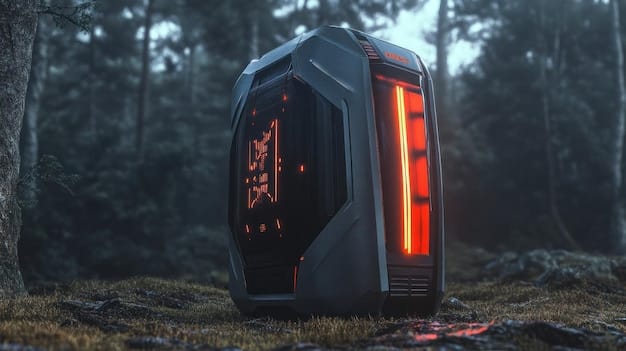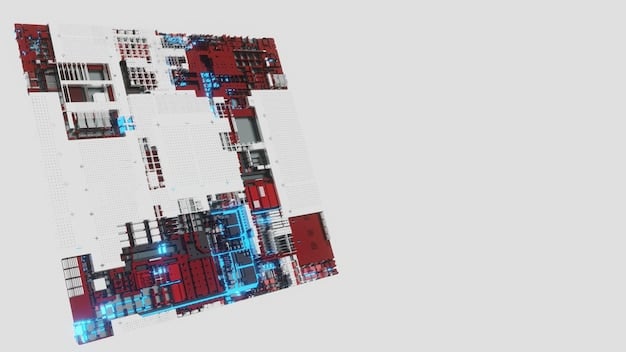Will NVIDIA RTX 5000 Series End 4K Bottlenecks in 2025?

NVIDIA’s RTX 5000 Series, anticipated for 2025, aims to revolutionize 4K gaming by potentially eliminating bottlenecks through advancements in architecture, memory, and processing power, offering smoother and more immersive high-resolution gaming experiences.
Will NVIDIA’s next-generation RTX 5000 series finally deliver on the promise of bottleneck-free 4K gaming in 2025? The answer lies in a deep dive into the architecture, expected improvements, and competitive landscape.
Understanding the Current 4K Gaming Bottleneck
Gaming at 4K resolution demands substantial processing power. Current GPUs sometimes struggle to maintain high frame rates, causing bottlenecks that impact the overall gaming experience. These bottlenecks can stem from various factors.
GPU Limitations
The graphics processing unit (GPU) is the heart of any gaming rig. Its ability to render complex scenes determines the final output. Inadequate GPU power leads to frame rate drops and stutters.
CPU Bottlenecks
While the GPU handles graphical tasks, the central processing unit (CPU) manages game logic, physics, and AI. An underpowered CPU can limit the GPU’s potential, causing a bottleneck. A faster CPU is necessary to maintain the flow of graphical instructions to the GPU without interruption.

Memory and Bandwidth
Sufficient memory and bandwidth are crucial for 4K gaming. Inadequate VRAM (Video RAM) can force the GPU to use system RAM, which is slower, leading to performance degradation. Effective memory bandwidth ensures the GPU can quickly access the necessary textures and data.
- Insufficient VRAM limits texture loading and resolution scaling.
- Low memory bandwidth slows data transfer between the GPU and memory.
- System RAM usage for graphics tasks causes significant performance drops.
Current 4K gaming bottlenecks arise from a combination of GPU limitations, CPU inadequacies, and memory constraints. Addressing these issues requires advancements across the board, which NVIDIA aims to deliver with the RTX 5000 series.
Architectural Innovations Expected in the RTX 5000 Series
NVIDIA’s new architecture is expected to bring significant improvements. These architectural enhancements are crucial for overcoming current limitations and enabling smoother 4K gaming. Let’s explore some expected innovations.
New GPU Architecture
A new GPU architecture typically involves enhanced core designs and improved efficiency. This allows the GPU to process more data per clock cycle, boosting overall performance. Enhanced ray tracing capabilities are also anticipated.
Increased CUDA Cores
CUDA cores are the building blocks of NVIDIA GPUs, responsible for parallel processing. Increasing the number of CUDA cores can significantly improve rendering speeds and overall performance. This increase is vital for handling the demands of 4K gaming.
Improved Ray Tracing
Ray tracing is a rendering technique that simulates light behavior for realistic visuals. However, it’s computationally intensive. Improved ray tracing cores in the RTX 5000 series could make ray tracing more viable at 4K resolution without substantial performance hits, meaning more realistic visual rendering.
- Enhanced ray tracing cores accelerate light and shadow calculations.
- Improved AI-based denoising reduces noise artifacts in ray-traced scenes.
- More efficient architecture allows for ray tracing at higher frame rates.
Expectations are high for NVIDIA to integrate architectural innovations that address the performance demands of 4K gaming, potentially eliminating major bottlenecks and improving the overall visual experience.

Memory and Bandwidth Enhancements
Memory and bandwidth play a crucial role in 4K gaming performance. Enhancements in these areas can significantly alleviate bottlenecks. NVIDIA is expected to introduce advancements to address these needs.
Faster Memory Technology
New memory technologies like GDDR7 or improved GDDR6X could offer higher bandwidth and faster speeds. This allows the GPU to access data more quickly, preventing bottlenecks. Expect memory speeds to increase substantially, which will be helpful for rendering and loading large textures and data sets at 4K resolution.
Wider Memory Bus
A wider memory bus increases the amount of data that can be transferred simultaneously. This can improve overall bandwidth and reduce memory-related bottlenecks. Increasing the width of the memory bus will likely be a key feature of RTX 5000 series cards. For example moving from a 384-bit bus to a 512-bit bus, enabling faster throughput.
Advanced Memory Compression
Advanced memory compression techniques can reduce the amount of data that needs to be transferred, effectively increasing bandwidth. Technologies like lossless compression algorithms ensures quicker and efficient data handling, reducing the strain on memory. This minimizes bottlenecks and improves performance, particularly at high resolutions like 4K.
These memory and bandwidth enhancements together will improve the GPU’s ability to manage and process the large amounts of data required for 4K gaming.
Potential Impact on 4K Gaming Performance
The expected improvements in the RTX 5000 series hold significant promise for 4K gaming. A variety of tests and benchmarks are often used to measure the effects.
Higher Frame Rates
One of the most noticeable impacts will be higher frame rates at 4K resolution. This means smoother gameplay and a more responsive gaming experience. A consistent 60 FPS or higher will become more achievable in demanding titles.
Improved Ray Tracing Performance
Improved ray tracing capabilities will allow gamers to enjoy realistic visuals without significant performance penalties. This could make ray tracing a more viable option for 4K gaming.
Reduced Latency
Advancements in GPU architecture and memory can reduce latency, resulting in more responsive gameplay. This is particularly important for competitive gaming, where every millisecond counts.
- Smoother gameplay with fewer stutters and frame drops
- More responsive controls due to reduced latency
- Enhanced visual fidelity with ray tracing enabled
Overall, the RTX 5000 series is poised to deliver a substantial boost in 4K gaming performance, bridging the gap between visual quality and smooth gameplay. The elimination of bottlenecks promises to redefine expectations for high-resolution gaming.
Competition and Market Positioning
The RTX 5000 series won’t exist in a vacuum. Competition from other GPU manufacturers will influence its performance and pricing. Understanding the competitive landscape is essential.
AMD’s Offerings
AMD is NVIDIA’s main competitor in the GPU market. Their next-generation GPUs will also aim to improve 4K gaming performance. The rivalry benefits consumers by driving innovation and lowering prices. AMD’s offerings are expected to be closely aligned with NVIDIA, creating a challenging environment for both companies to differentiate themselves.
Intel’s Entry
Intel has entered the discrete GPU market with their Arc series. While they are still relatively new, they have the potential to disrupt the market. Intel’s competitive pricing and performance could affect NVIDIA’s market positioning and accelerate the race to improve 4K gaming experiences for users.
Pricing Strategies
Pricing will play a crucial role in the success of the RTX 5000 series. NVIDIA will need to balance performance with affordability to remain competitive. The pricing strategies adopted for the RTX 5000 series will determine its accessibility to the wider gaming community and influence its market share.
NVIDIA’s market success will depend on how well the RTX 5000 series performs against competitor offerings. Competitive pricing and innovative features will be crucial for maintaining their market position. The competitive landscape ensures faster technological advancements, benefiting gamers in terms of both price and performance.
Challenges and Potential Roadblocks
Despite the optimism surrounding the RTX 5000 series, several challenges and potential roadblocks could impact its performance and availability. It’s essential to consider these factors.
Manufacturing Constraints
Global chip shortages and manufacturing constraints could limit the supply of RTX 5000 series cards. This would lead to higher prices and limited availability. NVIDIA must navigate these challenges to meet the anticipated demand.
Software Optimization
Even powerful hardware requires proper software optimization. Games and drivers need to be optimized to take full advantage of the RTX 5000 series’ capabilities. Without adequate optimization, gamers may not see the full performance potential of the new GPUs. Games that have not been optimized for newer RTX cards and their ray tracing technologies may struggle with latency and lower frame rates.
Power Consumption and Cooling
Increased performance often comes with increased power consumption. The RTX 5000 series may require more powerful power supplies and advanced cooling solutions. Higher power consumption will necessitate better thermal management solutions.
- Chip shortages impacting production and availability.
- Suboptimal software and driver support reducing performance gains.
- High power consumption requiring robust cooling systems.
Addressing these challenges is critical for NVIDIA to deliver on the promise of bottleneck-free 4K gaming with the RTX 5000 series. Overcoming these obstacles will solidify the series’ success and impact on the gaming world.
| Key Point | Brief Description |
|---|---|
| 🚀 Architectural Innovations | New GPU design for enhanced efficiency and performance. |
| ⚡️ Memory Enhancements | Faster GDDR7 memory and wider bus reduce bottlenecks. |
| 🎮 Improved 4K Gaming | Higher frame rates and better ray tracing at 4K resolution. |
| ⚠️ Potential Challenges | Manufacturing constraints and software optimization needs scrutiny. |
FAQ
▼
Current 4K gaming bottlenecks include GPU limitations, CPU inadequacies, and memory constraints. These issues collectively impact frame rates and overall gaming experiences.
▼
The RTX 5000 series is expected to feature a new GPU architecture with enhanced cores, increased CUDA cores, and improved ray tracing capabilities for better processing power.
▼
The RTX 5000 series may include faster memory technologies like GDDR7 or improved GDDR6X, wider memory buses, and advanced compression techniques for improved bandwidth.
▼
NVIDIA’s main competitors are AMD with their Radeon series, and Intel, who has recently entered the discrete GPU market with their Arc series of GPUs.
▼
Potential challenges include manufacturing constraints, the need for software optimization, and concerns over increased power consumption and cooling requirements.
Conclusion
The NVIDIA RTX 5000 series holds considerable promise for revolutionizing 4K gaming by potentially overcoming existing bottlenecks through architectural innovations and enhancements in memory and bandwidth. While challenges persist, the outlook is optimistic, suggesting a significant step forward in gaming technology by 2025. These improvements will make 4K gaming more efficient and immersive, improving the overall computing and gaming experience.





